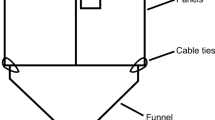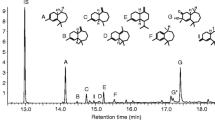Abstract
A male-produced aggregation pheromone was identified for the Australian sap beetle,Carpophilus davidsoni Dobson (Coleoptera: Nitidulidae), by bioassay-guided fractionation of volatiles collected from feeding beetles. The most abundant components were: (2E,4E,6E)-5-ethyl-3-methyl-2,4,6-nonatriene, (3E,5E,7E)-6-ethyl-4-methyl-3,5,7-decatriene, (2E,4E,6E,8E)-3,5,7-trimethyl-2,4,6,8-undecatetraene, and (2E,4E,6E,8E)-7-ethyl-3,5-dimethyl-2,4,6,8-undecatetraene. The relative abundance of these components in collections from individual males feeding on artificial diet was 100:7:9:31, respectively. Pheromone production began within several days after males were placed onto diet medium and continued for at least 20 weeks. Peak production was >3 µg total pheromone per male per day. Males in groups of 50–60 emitted less pheromone (the peak level was 0.09 µg per beetle per day), and the emissions from groups contained relatively little tetraene (proportions of the components listed above were 100:7:2:7, respectively). Three additional trienes and one additional tetraene were identified in minor amounts; the entire eight-component male-specific blend is qualitatively identical and quantitatively similar to that of the North American sibling species,C. freemani Dobson. A synthetic blend of the four major components on rubber septa, prepared to emit in the same proportions as from individual males, was highly attractive in the field when synergized with fermenting whole-wheat bread dough. Cross-attraction was observed in the field involving the pheromones ofC. davidsoni, C. hemipterus (L.), andC. mutilatus Erichson. Potential uses of the pheromones in pest management are discussed.
Similar content being viewed by others
References
Bartelt, R.J., Dowd, P.F., Plattner, R.D., andWeisleder, D. 1990a. Aggregation pheromone of driedfruit beetle,Carpophilus hemipterus: Wind-tunnel bioassay and identification of two novel tetraene hydrocarbons.J. Chem. Ecol. 16:1015–1039.
Bartelt, R.J., Dowd, P.F., Shorey, H.H., andWeisleder, D. 1990b. Aggregation pheromone ofCarpophilus freemani (Coleoptera: Nitidulidae): A blend of conjugated triene and tetraene hydrocarbons.Chemoecology 1:105–113.
Bartelt, R.J., Weisleder, D., Dowd, P.F., andPlattner, R.D. 1992. Male-specific tetraene and triene hydrocarbons ofCarpophilus hemipterus: Structure and pheromonal activity.J. Chem. Ecol. 18:379–402.
Bartelt, R.J., Vetter, R.S., Carlson, D.G., andBaker, T.C. 1993. Male-produced aggregation pheromone ofCarpophilus mutilatus (Coleoptera: Nitidulidae).J. Chem. Ecol. 19:107–118.
Dobson, R.M. 1952. A new species ofCarpophilus Stephens (Col., Nitidulidae) from Australia.Entomol. Mon. Mag. 88:256–258.
Dowd, P.F., andWeber, C.M. 1991. A labor-saving method for rearing a corn sap beetle,Carpophilus freemani Dobson (Coleoptera: Nitidulidae), on pinto bean-based diet.J. Agric. Entomol. 8:149–153.
Dowd, P.F., Bartelt, R.J., andWicklow, D.T. 1992. Novel insect trap useful in capturing sap beetles (Coleoptera: Nitidulidae) and other flying insects.J. Econ. Entomol. 85:772–778.
Gillogly, L.R. 1962. Coleoptera: Nitidulidae. Insects Micronesia 16:133–188.
James, D.G., Bartelt, R.J., Faulder, R.J., andTaylor, A. 1993. Attraction of AustralianCarpophilus spp. (Coleoptera: Nitidulidae) to synthetic pheromones and fermenting bread dough.J. Aust. Entomol. Soc. 32:339–345.
James, D.G., Bartelt, R.J., andFaulder, R.J. 1994. Attraction ofCarpophilus spp. (Coleoptera: Nitidulidae) to synthetic aggregation pheromones and host-related coattractants in Australian stone fruit orchards: Beetle phenology and pheromone dose studies.J. Chem. Ecol. 20:2805–2820.
McDonough, L.M. 1991. Controlled release of insect sex pheromones from a natural rubber substrate, pp. 106–124,in P.A. Hedin (ed.). Naturally Occurring Pest Bioregulators. American Chemical Society Symposium Series 449. American Chemical Society, Washington, D.C.
Poole, C.F., andSchuette, S.A. 1984. Contemporary Practice of Chromatography. Elsevier, Amsterdam, 708 pp.
Williams, R.N., Fickle, D.S., Kehat, M., Blumberg, D., andKlein, M.G. 1983. Bibliography of the genusCarpophilus Stephens (Coleoptera: Nitidulidae). Ohio State University Research Circular 278, Ohio Agricultural Research and Development Center, Wooster, Ohio.
Author information
Authors and Affiliations
Additional information
Names are necessary to report factually on available data; however, the USDA neither guarantees nor warrants the standards of the products, and the use of the names by USDA implies no approval of the products to the exclusion of others that may also be suitable.
Rights and permissions
About this article
Cite this article
Bartelt, R.J., James, D.G. Aggregation pheromone of Australian SAP beetle,Carpophilus davidsoni (Coleoptera: Nitidulidae). J Chem Ecol 20, 3207–3219 (1994). https://doi.org/10.1007/BF02033721
Received:
Accepted:
Issue Date:
DOI: https://doi.org/10.1007/BF02033721




